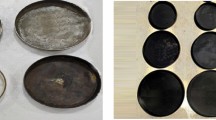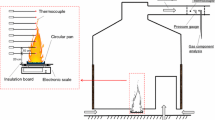Abstract
In order to understand the combustion characteristics of crude oil pool fires, an experimental study was carried out at the Fire Research Institute (FRI) large scale test facility. The radiative output, burning rate, and the concentrations of CO, CO2, and smoke (above the flame tip) were measured during the burning of Arabian light crude oil, heptane, toluene, and kerosene floating on water. The effect of scale was studied by using steel pans ranging from 0.6 to 3 meters in diameter.
Crude oil burned less rapidly and gave off less thermal radiation compared with heptane, but when water boiling, i.e., boilover, occurred, the burning rate increased by a factor of two or more. The intensity of boilover is related to pan diameter and initial fuel layer thickness.
Similar content being viewed by others
References
Henry, M., and Klem, T., “Scores Die in Tank Fire Boilover,”Fire Service Today, p. 11 (June 1983).
“Safety Codes in Doubt after Britain's Largest Postwar Refinery Fire,”Fire Prevention,169, pp. 36–38 (1983).
“Tank Farm Burns for a Whole Week,” Fire Prevention Bulletin, 082, pp. 19–26, (1988).
Hasegawa, K., “Experimental Study on the Mechanism of Hot Zone Formation in Open-Tank Fires,” Proceeding of the Second International Symposium on Fire Safety Science, p. 221 (1988).
Evans, D., Mulholland, G., Gross, D., and Baum, H., “Environmental Effects of Oil Spill Combustion,” Proceeding of the Tenth Arctic Marine Oil Spill Program Technical Seminar (1987).
Arai, M., Saito, K., and Altenkirch, R. A., “A Study of Boilover in Liquid Pool Fires Supported on Water, Part 1: Effects of a Water Sublayer on Pool Fires,”Combustion Science and Technology 71, p. 25 (1990).
Brzustowski, T. A. and Twardus, E. M., “A Study of the Burning of a Slick of Crude Oil on Water,” 19th Symposium Inter. on Combustion, The Combustion Institute, p. 847 (1982).
Mulholland, G. W., Henzel, V., and Babrauskas, V., “The Effect of Scale on Smoke Emission,” Proceedings of the Second International Symposium on Fire Safety Science, p. 347 (1988).
Yumoto, T., “An Experimental Study on Heat Radiation from Oil Tank Fire,” Fire Research Institute, “Report of Oil Tank Fire,” Fire Research Institute Report No. 33, p. 23 (1971).
“Report of Oil Tank Fire Extinguishment,” Fire Research Institute, Technical Report of FRI No. 8 (1976).
“Report of Oil Tank Fire Experiment,” Japan Soc. of Safety Eng., (1979).
Benner, B. A., Jr., Bryner, N. P., Stephen, A. W., Mulholland, G. W., Lao, R. C., and Fingas, M. F., “Polycyclic Aromatic Hydrocarbon Emissions from the Combustion of Crude Oil on Water,”Environmental Science and Technology 24,9, p. 1418 (1990).
Koseki, H. and Yumoto, T., “Air Entrainment and Thermal Radiation from Heptane Pool Fires,”Fire Technology,24,1, p. 33 (1988).
Author information
Authors and Affiliations
Rights and permissions
About this article
Cite this article
Koseki, H., Mulholland, G.W. The effect of diameter on the burning of crude oil pool fires. Fire Technol 27, 54–65 (1991). https://doi.org/10.1007/BF01039527
Issue Date:
DOI: https://doi.org/10.1007/BF01039527




